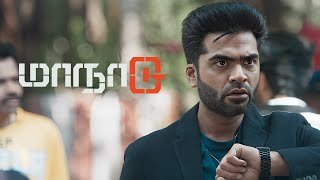Maanaadu, directed by Venkat Prabhu, is not just a sci-fi action thriller—it is a temporal chess game wrapped in political allegory. A film that weaponizes the time loop concept to interrogate the machinery of politics, identity, and agency, Maanaadu dares to ask: What happens when a powerless man wakes up to infinite power? And more pressingly—how do you escape a loop designed to keep the truth buried?
Beneath its stylish stunts and comic relief lies a layered parable about fate, faith, corruption, and the audacity of rebellion. It is not a film about science. It is a film about liberation through repetition.
Narrative Core: The Politics of Recurrence
At the center of Maanaadu is Abdul Khaliq, an ordinary man drawn into an extraordinary situation. He finds himself caught in a time loop, reliving the same day—specifically a day that climaxes in a violent political assassination at a high-profile public event. But unlike most time loop stories where the protagonist uses the loop for personal growth or emotional closure, Khaliq’s journey is tethered to a political conspiracy that weaponizes communal tension.
The assassination of the Chief Minister is a false-flag operation, designed to spark riots and scapegoat minorities. Through each iteration of the loop, Khaliq uncovers layers of this plot, its architects, and most importantly—his own power to challenge it.
This isn’t about saving just one life. It’s about rewriting a systemically rigged script.
Structure: Chaos Engineered With Precision
Maanaadu plays a delicate game with narrative structure. The first act appears to be a simple thriller with red herrings, comedic relief, and expository buildup. But once the time loop kicks in, the film becomes a kinetic puzzle. Every repetition adds new variables—knowledge, strategy, alliances.
Unlike films that let repetition dull tension, Maanaadu uses the loop to increase stakes. The audience is not merely watching Khaliq repeat events—they are watching him become a tactician. Each loop becomes a lesson. He learns how to survive, how to manipulate space and time, and eventually—how to outwit the architect of the loop itself, the antagonist Dhanushkodi, a police officer who represents the machinery of state oppression.
The brilliance of the structure is how entropy turns into symmetry. What begins as chaos gradually crystallizes into a master plan. Not of fate’s design, but of Khaliq’s.
Thematic Layers: Time as a Metaphor for Oppression
1. The Repetition of Violence
In a political system rooted in communal divisions, the violence never ends. Riots, false accusations, cycles of hate—they keep happening. The time loop becomes a metaphor for how the same crimes keep repeating, especially against marginalized groups.
Khaliq isn’t just trapped in time. He’s trapped in a social loop of prejudice. In every iteration, his identity as a Muslim becomes a target. Whether it’s suspicion from the public or betrayal by the authorities, his existence is a reminder of the societal loop that criminalizes the ‘other.’
The only way to break the loop? Expose the root system, not just the symptoms.
2. Control vs. Free Will
The antagonist, Dhanushkodi, plays god. Once he discovers he too is in the loop, he uses it to tighten control, while Khaliq uses it to liberate. The contrast here is profound: one uses knowledge to oppress; the other to free people from the illusion of destiny.
The film raises a fundamental question: If you could relive a day, would you fix it for yourself—or for everyone else? Khaliq’s answer is revolutionary.
3. Identity as a Weapon and a Wound
Khaliq’s identity—his faith, his appearance, his name—are central to the narrative. He is constantly framed, suspected, hunted. Yet, his identity also becomes his moral compass. He never kills needlessly. He never abandons hope. His repeated deaths are almost symbolic martyrdoms, sacrifices in pursuit of justice.
The loop does not erase his identity. It refines his purpose.
Character Analysis: Evolution in Recursion
Abdul Khaliq – The Reluctant Revolutionary
Khaliq begins as an everyman—confused, reactive, desperate. But unlike typical heroes who grow linearly, Khaliq’s arc is circular but cumulative. Every time he dies, he returns sharper, calmer, more aware. He becomes a strategist not by training, but by sheer necessity.
More importantly, he never loses his humanity. He weeps, pleads, questions, and eventually chooses to lead—not for fame or revenge, but because he has the knowledge and the moral urgency to stop a bloodbath. He turns the loop into his weapon.
Khaliq is not just breaking time—he’s breaking a cycle of political manipulation that sacrifices people like him.
Dhanushkodi – The God Complex
The antagonist is one of the film’s most intriguing figures. A high-ranking cop, Dhanushkodi is both a mastermind and a prisoner. Once he realizes he too is in the loop, he becomes obsessed—not with justice, but absolute control.
He represents the state apparatus—polished, confident, ruthless. He’s not a madman, but a hyper-rationalist who sees human lives as variables in a larger equation. What makes him dangerous isn’t his cruelty—it’s his belief that he’s right.
His final confrontation with Khaliq is not just a battle of guns, but a war of worldviews. Who owns time? Who decides fate? Who deserves power?
Supporting Cast – The Echoes of the Loop
The secondary characters—Seethalakshmi, the CM, and even Khaliq’s companions—are not static either. Though their memories don’t carry through the loop, their actions begin to shift based on Khaliq’s interventions. This subtle rewriting of behavior emphasizes the idea that change doesn’t come from a system—it comes from persistent individuals.
Stylistic Choices: Genre Rebellion
1. Cinematic Language
Visually, Maanaadu uses kinetic editing and handheld shots to create a sense of disorientation in early loops, which gradually transitions to clean, symmetrical framing as Khaliq gains control. The looping day is stylized but grounded in gritty realism—crowds, traffic, bureaucratic offices, and public chaos.
The music is pulsing, repetitive, often mimicking the feeling of a ticking clock or a heartbeat. It enhances the urgency without becoming melodramatic.
2. Humor and Relief
Despite its heavy themes, the film never becomes preachy or grim. The inclusion of humor, especially during Khaliq’s early attempts to understand the loop, adds levity and relatability. The humor is not to undermine the stakes but to humanize the experience. A man caught in an impossible situation still finds moments to smile.
Symbolism and Subtext
The Loop as Karma
There’s a philosophical undercurrent that blends Eastern and Western ideas of time. The loop is not just a plot device—it resembles karma. Actions have consequences. Repetition is a form of cosmic correction. Until the correct moral action is chosen, the day resets. The film suggests that transformation is only possible through conscious suffering and repeated ethical choice.
The Bullet as Truth
The bullet that triggers the reset becomes a symbol of truth. Every time it fires, reality resets. It’s both death and rebirth. Khaliq begins to use it not as an end, but as a means to begin again. By the end, he controls the bullet—both literally and symbolically. He decides when to die, and when to change history.
Conclusion: A Loop Broken by Courage
Maanaadu is a rare film that combines mass appeal with layered storytelling. It turns a sci-fi gimmick into a political allegory. It gives its hero not just the power to escape, but the will to redeem an entire system. It doesn’t preach revolution—it models it.
In a world where time often feels cyclical—where the same injustices keep occurring—Maanaadu is a cinematic metaphor for resistance through knowledge. You may die a thousand times, but if your cause is just, you’ll learn how to win.
Khaliq doesn’t escape the loop by luck. He earns it through persistence, morality, and clarity of purpose. And in doing so, he offers a blueprint—not just for breaking a time loop, but for rewriting the narrative imposed by oppressive systems.

